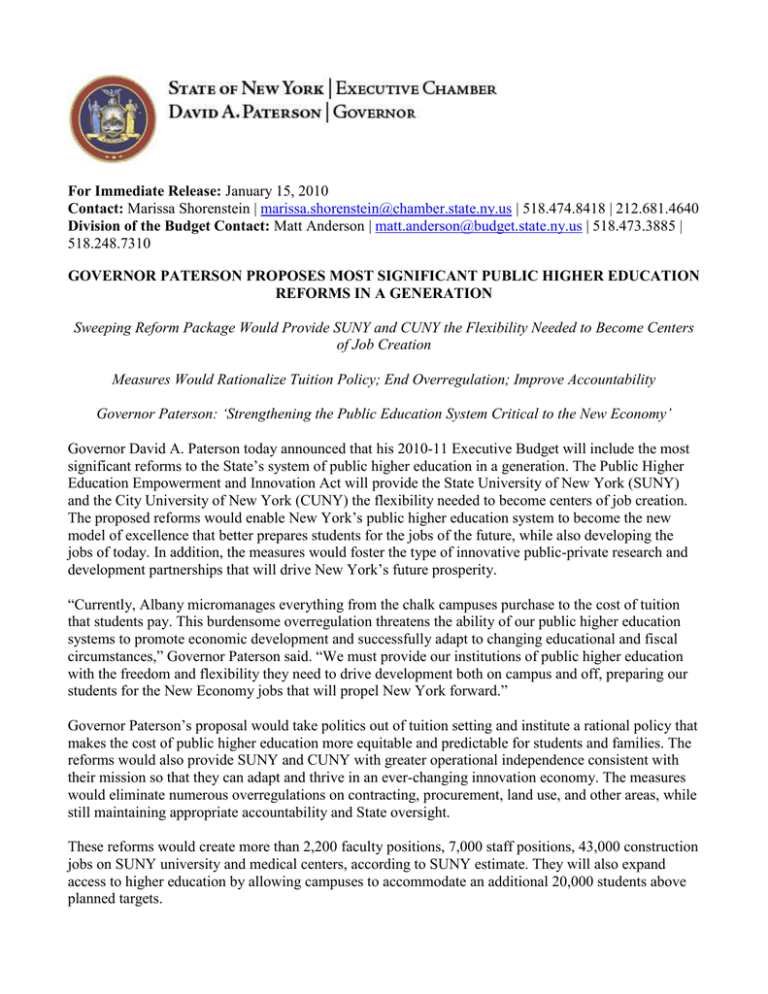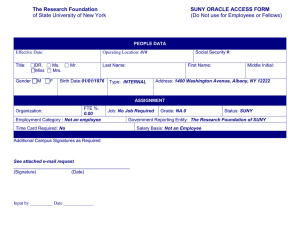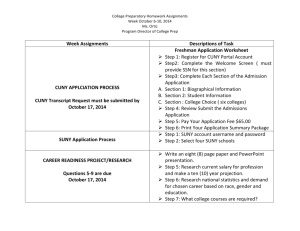State of New York | Executive Chamber For Immediate Release: Contact:
advertisement

State of New York | Executive Chamber For Immediate Release: January 15, 2010 Contact: Marissa Shorenstein | marissa.shorenstein@chamber.state.ny.us | 518.474.8418 | 212.681.4640 Division of the Budget Contact: Matt Anderson | matt.anderson@budget.state.ny.us | 518.473.3885 | 518.248.7310 GOVERNOR PATERSON PROPOSES MOST SIGNIFICANT PUBLIC HIGHER EDUCATION REFORMS IN A GENERATION Sweeping Reform Package Would Provide SUNY and CUNY the Flexibility Needed to Become Centers of Job Creation Measures Would Rationalize Tuition Policy; End Overregulation; Improve Accountability Governor Paterson: ‘Strengthening the Public Education System Critical to the New Economy’ Governor David A. Paterson today announced that his 2010-11 Executive Budget will include the most significant reforms to the State’s system of public higher education in a generation. The Public Higher Education Empowerment and Innovation Act will provide the State University of New York (SUNY) and the City University of New York (CUNY) the flexibility needed to become centers of job creation. The proposed reforms would enable New York’s public higher education system to become the new model of excellence that better prepares students for the jobs of the future, while also developing the jobs of today. In addition, the measures would foster the type of innovative public-private research and development partnerships that will drive New York’s future prosperity. “Currently, Albany micromanages everything from the chalk campuses purchase to the cost of tuition that students pay. This burdensome overregulation threatens the ability of our public higher education systems to promote economic development and successfully adapt to changing educational and fiscal circumstances,” Governor Paterson said. “We must provide our institutions of public higher education with the freedom and flexibility they need to drive development both on campus and off, preparing our students for the New Economy jobs that will propel New York forward.” Governor Paterson’s proposal would take politics out of tuition setting and institute a rational policy that makes the cost of public higher education more equitable and predictable for students and families. The reforms would also provide SUNY and CUNY with greater operational independence consistent with their mission so that they can adapt and thrive in an ever-changing innovation economy. The measures would eliminate numerous overregulations on contracting, procurement, land use, and other areas, while still maintaining appropriate accountability and State oversight. These reforms would create more than 2,200 faculty positions, 7,000 staff positions, 43,000 construction jobs on SUNY university and medical centers, according to SUNY estimate. They will also expand access to higher education by allowing campuses to accommodate an additional 20,000 students above planned targets. SUNY Chancellor Nancy L. Zimpher said: “I commend Governor Paterson for his leadership in bringing forward the Public Higher Education Empowerment and Innovation Act. This legislation harnesses high-impact, zero-cost solutions that will create jobs, build the foundation for tomorrow’s economy and strengthen public higher education – while saving millions of taxpayer dollars. “With the unprecedented cooperation and energetic partnership of SUNY and CUNY, we have taken a major step in unleashing the public university sector to achieve the promise of economic growth through top quality education, from community college to research center. This will positively impact every community in the state with the creation of tens of thousands of new jobs and through billions of dollars in local investment.” CUNY Chancellor Matthew Goldstein said: “We commend Governor Paterson for his exemplary efforts to address flexibility in the financing of public higher education. CUNY is experiencing record student enrollments as we now serve over 260,000 degree-seeking students--the highest level in CUNY’s history and a 7 percent increase over the past year. In addition, 2010 Spring enrollments are up 14 percent. Freshman applications for Fall 2010 are up 10 percent. In these difficult fiscal times, budget flexibility will enable the University to strengthen its responsiveness to the changing needs of students and to the changing economy. In order for New York State to compete effectively nationally and in the global marketplace of careers and ideas, its public higher education systems must have the necessary flexibility and investment to carry out their educational mission. We are pleased to continue working with the Governor and the State Legislature to accomplish that vital goal.” Rational Tuition Policy – Ending Tuition Roulette Currently, SUNY and CUNY tuition rates are determined by the State budget process. This has created a system in which tuition increases occur almost exclusively to close State budget gaps and offset General Fund support during periods of economic distress – a time when students and their families are least able to afford additional costs. Moreover, these long periods between tuition rate increases result in some students completing their degree programs without experiencing a tuition increase, while those attending college during fiscal downturns experience significant tuition hikes. This is an unfair system that many independent experts have derided as “tuition roulette” and makes the cost of education unpredictable for students and families. Governor Paterson’s Public Higher Education Empowerment and Innovation Act addresses these issues by instituting a rational tuition policy that: Moves tuition outside the State budget process, allowing SUNY and CUNY to receive and disburse revenues from tuition and self-supporting program activities without an appropriation. Authorizes the boards of trustees for SUNY and CUNY to implement a fair, equitable and responsible tuition policy that would provide the universities with the discretion to raise tuition incrementally up to an annual cap of two and one half times the five-year rolling average of the Higher Education Price Index (HEPI), making it easier for students and families to anticipate and plan for the true cost of attendance over the course of a degree program. Authorizes the SUNY and CUNY trustees to implement differential tuition rates for programs and campuses within their systems to enhance academic quality, based on the recommendation of the college president and in accordance with specific guidelines promulgated by the trustees. Ending Overregulation, Ensuring Accountability Under the current system, overregulation stifles both SUNY and CUNY’s ability to innovate and compete with peer institutions in other states. Governor Paterson’s proposed reforms would provide SUNY and CUNY with greater operational flexibility regarding the procurement of goods and contractual services; the procurement and financing of construction services; and the lease of campus property. The Public Higher Education Empowerment and Innovation Act would also: Authorize the lease of real property under the jurisdiction of SUNY to other entities in support of its educational purpose, and the participation in public/private partnerships that would benefit SUNY’s mission, and diversify its revenue streams, subject to approval of a newly created State University Asset Maximization Review Board. This will help encourage greater business opportunities and innovative research partnerships, since many potential private companies are unwilling or unable to wait the months or years it takes for a project to wind its way through the legislative and political process. Remove provisions of law subjecting SUNY and CUNY to pre-approval of contracts by the Office of the State Comptroller (OSC) in order to streamline the procurement of goods and services, while maintaining provisions requiring the post-audit of such contracts by OSC. Allow post-audit in lieu of pre-audit requirements for Attorney General approval of leases between SUNY and its alumni associations in support of dormitory projects. Prescribe specific semi-annual reporting requirements on revenues and expenditures at a campus-specific level to ensure continued transparency and accountability. “These are significant measures, but if we are to make New York the center for job creation, research and development in the New Economy, it is critical that we strengthen our public education system,” Governor Paterson added. ### Additional news available at www.ny.gov/governor/press High resolution images available at www.ny.gov/governor/mediaimages | password: paterson New York State | Executive Chamber | press.office@chamber.state.ny.us | 212.681.4640 | 518.474.8418

